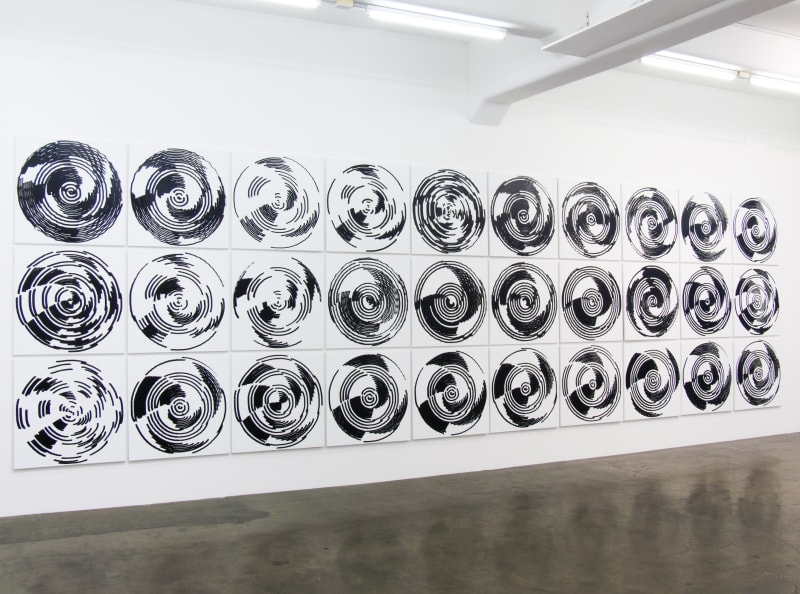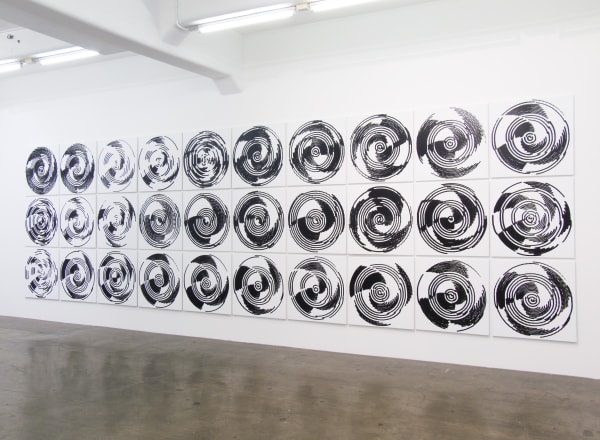Paintings of the Sun: Simon Ingram
For over a year Simon Ingram’s Radio Painting Station has been collecting energy emitted from hydrogen atoms undergoing “spin-flips” in space. The visual representation of this collection is a series of thirty concentrically circular compositions that materialise energy from the sun, and the interstellar medium, in a cartoon-like and painterly way. It is these that the artist chooses to present for his fourth solo exhibition Paintings of the Sun at Gow Langsford Gallery.
Radio Painting Station, set up at JAR in Kingsland, is one part amateur radio astronomer's lab, one part painting studio and one part gallery space. The entrance to the space is mostly glass and at street level, with passers-by able to see the progress of the project as a series of paintings multiplies. Local people see the project as their own - parents with children in prams, bar flies en route home late at night from Kingsland bars, dog walkers; all stop to talk with the artist about what is happening in the space.
The artist uses techniques and equipment of a painter turned amateur radio astronomer. Rather than looking for visible light with a telescope, he constructed a pyramid-like form and pointed it through a skylight to collect energy at the frequency of 1420 megahertz, then couples this to a special radio receiver and this to his machine. Radio Painting Station’s operation encompasses the period from the 4th of November 2013 to the 28th of April 2015. It was commissioned by Wystan Curnow and Susan Davis for JAR and supported generously by the Chartwell Trust. As well as temporarily turning JAR into an amateur radio astronomer’s painting studio, the artist installed a solar power system, electrifying it, as an off-the-grid project space.
In addition to Paintings of the Sun, a 152 page monograph published in 2014 by Kerber Verlag will be launched at the exhibition. The artist gratefully acknowledges those involved who worked to develop and publish this book: the publisher, writers and translators, and in particular, the book's editor, Christina Barton, Director of The Adam Art Gallery, and Toby Curnow at Inhouse Design.
(Anna Jackson, March 2015 )
“The place and act of painting in Ingram’s work is hosted in the public sphere. The actual painting of the canvas is a spectacle outside the studio, dislocated from the subjectivity of the artist and the romantic atelier. Adding to the intertextualities in the project’s mode of address, the translation of radio waves into steady, albeit ham-fisted marks problematises abstraction rather than aesthetising it. And at a time when contemporary painting relies so heavily on haptic qualities to affect viewers, Ingram removes his hand and locates materiality, not in the thingness of the painting but in the motorised apparatus that moves over its surface.”
Michelle Grabner, Painting Machines, Bielefeld: Kerber Verlag 2014, p. 128.
“By deferring to the machinic, by tuning his antennae towards the ether, by translating sound waves into computer code, Ingram allows that he (and we) are enmeshed within a much larger system. His works demonstrate, in both their mode of making and as finished products, the subtle, irrevocable connections between organic and manmade, technological and human, abstract and animate, visible and invisible, coded and real. He lets things show us something about themselves and reminds us that our minds and bodies are closer to nature and to machines than we might like to imagine.”
Christina Barton, Painting Machines, Bielefeld: Kerber Verlag 2014, p.6.
“The hydrogen line (1420.40575 MHz) is the precession frequency of neutral hydrogen atoms, the most abundant substance in space. It happens to fall in the quietest part of the radio spectrum, what's known as the Microwave Window. Although there may not seem to be a lot of loose hydrogen atoms about (there's perhaps one per cubic centimeter of interstellar space), the interstellar medium contains a lot of cubic centimeters. So these individual atoms chirping away at 1420 MHz make a powerful chorus, which is readily detected by even small radio telescopes.”
Dr. SETI, (2002, December 28). What is the Hydrogen Line? Retrieved from http://www.setileague.org/askdr/hydrogen.htm
Link to John Hurrell's review of Paintings of the Sun on EyeContact









